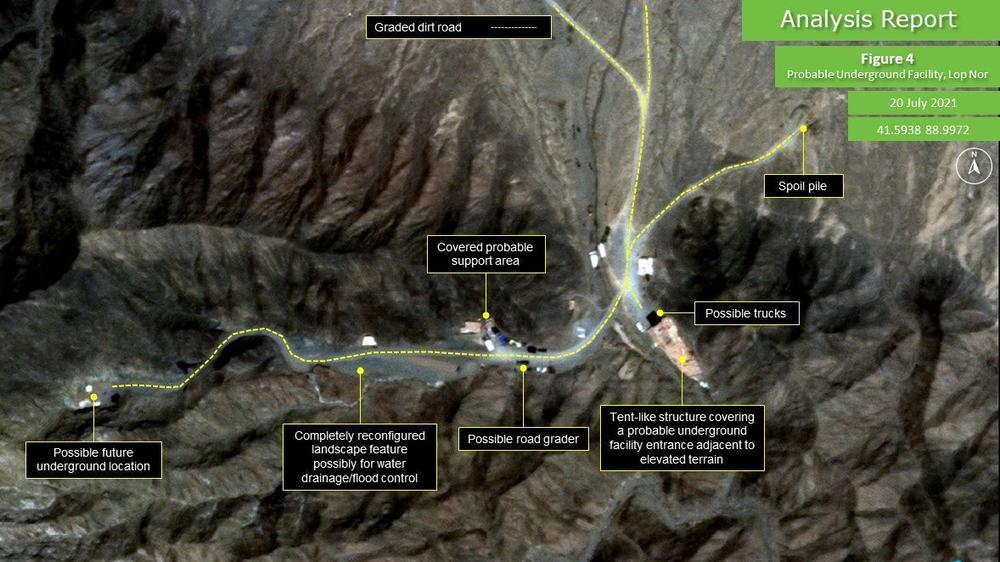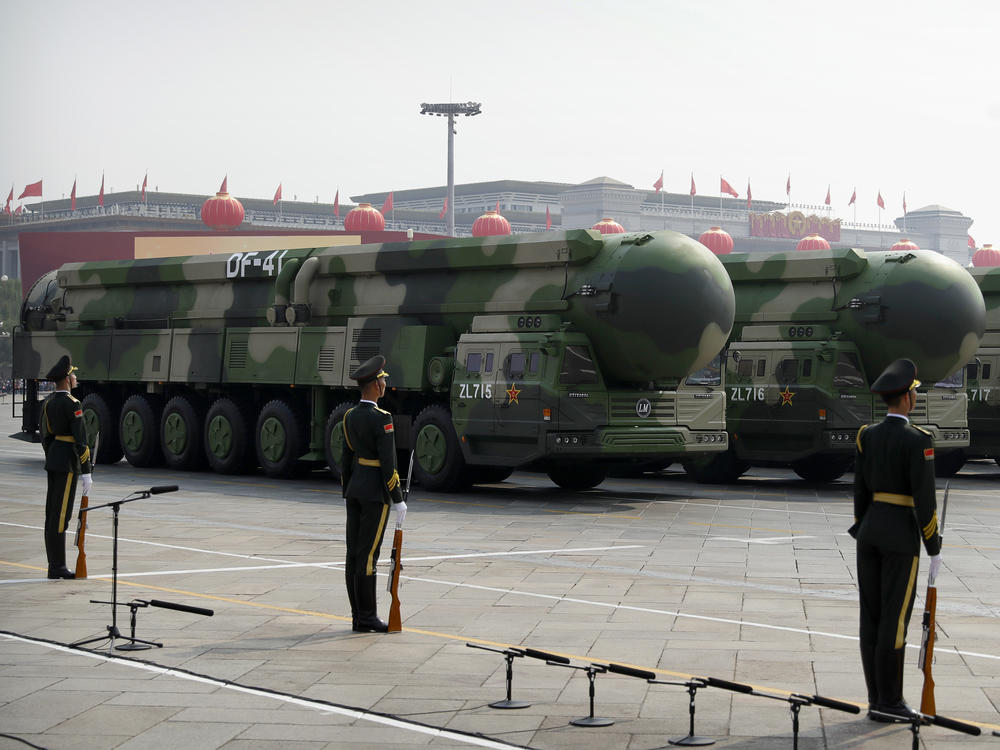Section Branding
Header Content
A New Tunnel Is Spotted At A Chinese Nuclear Test Site
Primary Content
China appears to be expanding its sprawling nuclear weapons testing complex in the nation's western desert. Satellite imagery shared exclusively with NPR shows a possible new tunnel being dug and fresh roads added at the site, known as Lop Nur, where China has tested its nuclear weapons in the past.
"This is new construction linked to areas that have in the past supported nuclear test activities," says Renny Babiarz, vice president for analysis and operations at AllSource Analysis, a private geospatial analysis firm that spotted the tunnel using satellite imagery from the commercial company Planet.
But Babiarz adds that it remains far from clear what the tunnel will be used for. China has not conducted full-scale nuclear testing since the 1990s, when it and the world's other major nuclear powers entered into a voluntary moratorium on testing. The Chinese government, and other nations including the U.S., have continued to test the nonnuclear components of nuclear weapons — sometimes underground.
Two new nuclear missile fields were discovered in other parts of China
In an email, Liu Pengyu, a spokesperson for the Chinese Embassy in Washington, D.C., declined to comment on the site itself, but he said that China "stays committed to the nuclear testing moratorium." He also objected to "unacceptable U.S. allegations" that the Chinese government was in any way trying to undermine the Comprehensive Test Ban Treaty, an unratified treaty that remains the basis for the global pause to nuclear testing.
The news of the new tunnel comes after two separate groups turned up giant nuclear missile fields under construction in other parts of the country earlier in the month.
"Over the past year and a half, China has constructed at least two large facilities, each with more than 100 missile silos," says Jeffrey Lewis, a professor at the Middlebury Institute of International Studies in Monterey, who announced the discovery of the first field on July 2. "China had 18 silos prior to this."
China's nuclear force can't compare to America's
Lewis notes that even with the newly discovered missile silos, China's nuclear force remains far smaller than America's. "We're getting worked up over 200 silos, which is something," he says. "But the United States has more than 400." The U.S. also has bombers and submarines capable of delivering a nuclear strike.
Still, the growth in China's nuclear arsenal may mark a departure from the nation's traditional attitude toward nuclear weapons. For decades, while the U.S. and Russia stockpiled many thousands of weapons, China maintained a so-called minimum deterrent of a few hundred warheads.
"It was never important for them to engage in the kind of arms race that you saw between the United States and the Soviet Union," says Lewis.
But China might be trying to change that
"When you look at their numbers juxtaposed against ours, it's a pretty significant difference," says Robert P. Ashley Jr., an adjunct senior fellow at the Center for a New American Security and former head of the U.S. Defense Intelligence Agency. He says he thinks China is now growing its nuclear arsenal as part of a much larger push to become a dominant global power. "Part of their strategy is to try to build out those numbers," he says.
Tong Zhao, a researcher at the Carnegie Endowment for International Peace based in Beijing, says he also sees evidence that China is starting to move away from that traditional view of nuclear weapons. "Increasingly, people are saying that a bigger arsenal will provide China with geopolitical benefit; it will make American decision-makers think twice," Zhao says.
He believes that China will continue to add silos, road-mobile missiles, submarines and bombers in the coming years.
"My guess is that this new nuclear buildup really receives support from the highest level," Zhao says. Though, he notes, China's nuclear policy is shrouded in secrecy.
The facilities at the test site in Lop Nur are likely tied to that larger expansion. Zhao notes that "China's smallest nuclear warhead design is still heavier than the American equivalent." He believes the nation may be trying to further shrink the size of its nukes so that missiles can carry more warheads on top. Testing at Lop Nur, even at a small scale, could aid in that development. It's also possible that China is conducting work to simply maintain its existing, aging arsenal of weapons.
Based in part on the relatively small size of the mountains where the tunnel is being dug, Lewis thinks the new tunnel will support smaller tests. "I am someone who thinks that it is probably what are called 'subcritical' nuclear tests, which the United States also does underground at our nuclear test site in Nevada," he says.
Without access to the site, it's hard to tell what exactly is going on
Such testing often involves only the nonnuclear components of a weapon. But earlier this year, a State Department report expressed concern that China may be conducting very small-scale tests using nuclear material at Lop Nur. Such tests would not trigger a full-scale detonation, but they would run counter to a voluntary "zero yield" standard adhered to by the U.S., U.K. and France. Chinese Embassy spokesperson Liu Pengyu rejected such allegations as "irresponsible."
Figuring out exactly what's going on at a remote site like Lop Nur is nearly impossible without on-the-ground access of the sort that sometimes comes with arms control agreements. The U.S. and China currently do not have any nuclear arms control pacts and "because we don't have that kind of dialogue, we're just guessing," Lewis says.
Lewis says arms control negotiations have gone nowhere, in part because the U.S. has failed to take seriously China's concerns about things such as missile defense. Zhao says that appetite for negotiations within the Chinese government is also low. "There is deep and longstanding suspicion within the Chinese expert community about arms control," he says.
Ultimately, Zhao says, he believes China's nuclear forces are going to keep growing in coming years. "We are just seeing the early signs of a nuclear race," he says. "Much more awaits us."
Copyright 2021 NPR. To see more, visit https://www.npr.org.


